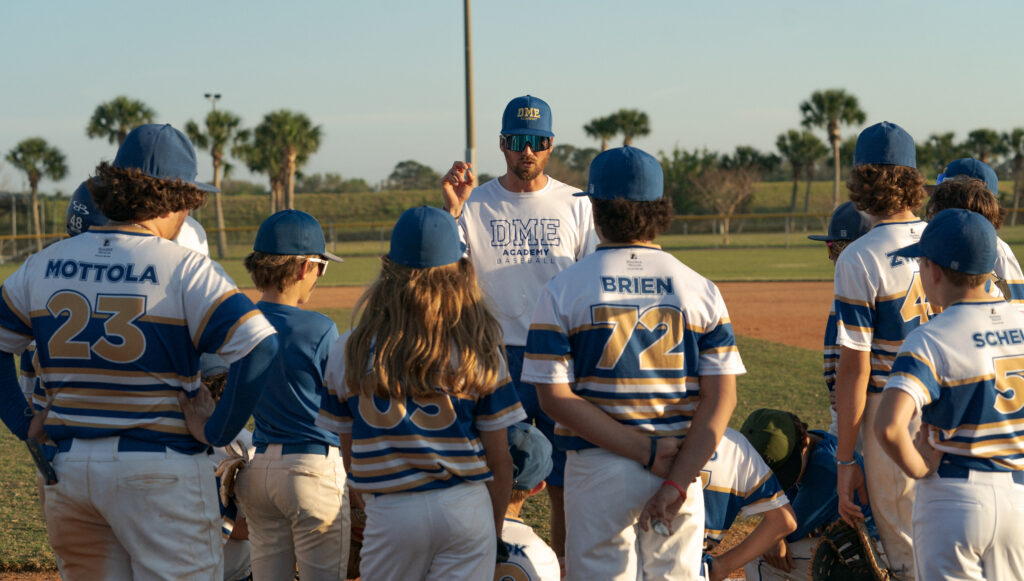Director of Baseball at DME Academy, Michael Main’s Tips for Training in the Off-Season for the Serious Baseball Athlete

Staying active is a crucial part of any baseball player’s off-season. Despite high school seasons coming to an end, athletes in Florida are fortunate enough to be able to train year-round at DME Academy! Here are the main things you should keep in mind during your summer baseball training from our Director of Baseball, Michael Main!
Strength and conditioning: Baseball student-athletes need to maintain their strength and conditioning during the summer. This can include a combination of weightlifting, bodyweight exercises, and cardiovascular activities. Emphasize exercises that target key muscle groups used in baseball, such as your core, legs, and upper body.
Skill development: At DME, we encourage our student-athletes to continue practicing their baseball skills during the summer. This includes hitting, throwing, fielding, and base-running drills. DME encourages our baseball players to practice with their teammates to boost competition and chemistry.
Flexibility and mobility: We can’t stress this enough, you NEED to stay flexible. We love seeing our athletes incorporating activities such as stretching, yoga, and mobility exercises into their routines. Flexibility and mobility can help prevent injuries, improve performance and enhance overall athleticism on the baseball diamond.
We understand many of you are in a hurry to strengthen your skills. But rest and recovery days are just as important as training days. Prioritizing rest lets your body recover to prevent burnout.
With rest and recovery also comes proper nutrition, hydration, and adequate sleep (NO ALL-NIGHT VIDEO GAME SESSIONS!).
Interested in training properly this upcoming Summer? Check out our upcoming Summer Prep camp!
Here is a sample baseball summer training plan written by DME Academy’s Director of Baseball, Michael Main for student-athletes. This program incorporates strength and conditioning, skill development, flexibility and mobility:
Strength and Conditioning (3-4 times per week):
Warm-up: Begin each session with a dynamic warm-up, including exercises such as jumping jacks, high knees, butt kicks, and lunges.
Resistance Training: Include exercises that target major muscle groups used in baseball, such as squats, lunges, deadlifts, bench presses, shoulder presses, and rows. Perform 3-4 sets of 8-12 reps for each exercise, progressively increasing weight as appropriate.
Core Training: Incorporate core exercises such as planks, Russian twists, medicine ball throws, and stability ball exercises. Aim for 2-3 sets of 15-20 reps or holds.
Plyometrics: Include explosive exercises like box jumps, medicine ball slams, and lateral bounds to improve power and athleticism. Perform 2-3 sets of 8-10 reps for each exercise.
Skill Development (3-4 times per week):
Hitting: Practice various hitting drills, including tee work, soft toss and live batting practice. Focus on technique, bat speed, and pitch recognition.
Throwing: Work on throwing mechanics, accuracy, and arm strength. Incorporate long toss drills, throwing against a wall, and partner drills.
Fielding: Practice fielding ground balls, pop-ups and working on footwork. Incorporate different fielding scenarios and positions to develop versatility.
Base-running: Work on speed, agility and base-running techniques. Include drills like sprint intervals, cone drills and baserunning simulations.
Flexibility and Mobility (3-4 times per week):
Dynamic Stretching: Perform dynamic stretching exercises such as leg swings, arm circles and hip rotations before each training session.
Static Stretching: Incorporate static stretches for major muscle groups after each workout or training session. Hold each stretch for 15-30 seconds.
Yoga or Pilates: Encourage participation in yoga or Pilates classes to improve flexibility, balance and body awareness.
Foam Rolling: Teach athletes to use foam rollers to self-massage and release tight muscles, enhancing recovery and flexibility.


